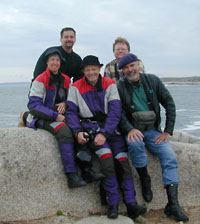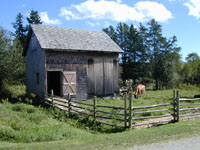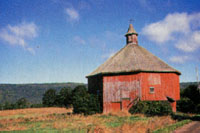|




































|
 |
 |
As I came down off
the mountains, headed toward the
sea-side town of Cheticamp, the spire of St. Peter’s church stood tall
above the low-lying roofs of the surrounding houses. The afternoon sun
glinted off the dark blue ocean, the light reflected from the brightly
painted homes and fishing boats, the smooth, soft emeraldness of the
coastal meadows backdropped by the muted fir-green of the Cape Breton
highlands.
This place was so
lovely I was all set to find myself a piece of property and move. The
scene reminded me of a beautiful woman, done up in her very best, at whose
feet, in my rather feckless youth, I would have thrown myself and begged
her to spend her life with me. I stopped at the Cheticamp harbor to allow
the vision to soak in.
|
| From left to right above:
Water power was the way lumber was sawn for hundreds of years before steam
or electricity came along; Santa Fe Dennis cruises past the lighthouse at
Peggy's Cove; the Cape Bretonites take a very traditional view of farming;
Louisbourg seen through a fortress wall; fishing boats docked in Mill's
Cove. |
| This trip was
cooked up by Northeastern Motorcycle Tours, and five of us had convened in
Bar Harbor, Maine, the previous week, to meet CEO Sean Reid and David, the
Chase. The tour had been touted not only as a superb ride, but also a
gastronomical extravaganza.
The first
meal was definitely up to palatal
snuff, as I savored my smoked salmon with caviar, followed by a pasta with
lobster sauce that arrived with a massive
heaping of crustacean on top.
We woke
early in order to make the fast catamaran ferry that runs between
Bar Harbor and Nova Scotia, except the poor Cat was mildly
crippled by the lack of one of its four 9,500-horsepower engines.
Put that in your Suzuki Hayabusa! However, repairs were in
progress, and the captain swore we would enjoy the full glory of the
sea-skimming boat on our return eight days hence.
Landing in
Yarmouth, our group headed out on a delightful run of the province’s
southwest coast. The reason people pay Reid good money to go on his trips
is that he knows the best roads to ride, the best places to eat, and the
best places to lay your head at night. We continued our gastronomical
adventuring at a little restaurant where the specialty of the house was
rappie pie. Scrumptious! And if you want to know what that dish is, go to
Nova Scotia, because Helen LeBlanc made me promise not to give out the
recipe. |
| As we
rippled along the narrow coastal roads, it was a most picturesque ride,
passing small harbors with fishing boats pulled to the wharves, neat
houses lining the waterfront, young mothers pushing baby carriages in the
waning light of the evening sun.
We came upon a
little ferry that plied 200 yards across La Havre River. "Wouldn’t
it be fun to take it?," I asked Reid. "Even more fun to do the
20 miles along the road to get to the other side," he replied.
Sensibly we did the road. |
 |
| On the waterfront
in Lunenburg - don't worry, this is a one-way street. |
|
| That evening
we bedded down in an old sea-captain’s house in Lunenburg, the residence
now an exquisite Bed and Breakfast. We ate three
scrumptious courses at a nearby inn using
many plates and regretting not a mouthful.
A number of
vears ago some bright lights in Nova Scotia realized that they were
sitting on an untapped tourist treasure. New
England had been done, and done to death, with gift shops and
motels filling every chink between Mystic Seaport and Acadia National
Park, but New Scotland was a whole new world. Americans could ride up and
get on a ferry and be in a distant land in less than a day. |
 |
The
Nova Scotians love the tourists, too, being by nature an extremely
friendly lot, and genuinely so. They are happy to talk, ask about
your
travels, lend you their own phone to call the office. Yes, I stopped at a
gas station in a remote village, Cape North, and asked if there were a pay
phone. “No,” said the woman at the counter, whereupon she cheerfully
offered me her own portable instrument. I liked that.
Traveling
the back roads we could not help but absorb much of the history of the
place, as the Scotians have done an excellent job of preserving or
resurrecting much of their past. Sherbrooke Village is a turn back to the
1860s, whereas the astounding re-creation of the Fortress of Louisbourg is
like stepping into the 1740s—seeing
Louisbourg alone is
worth the price of the
trip. |
| This
Canadian province covers some 21,000 square miles, bigger than New
Hampshire and Vermont combined, and has less than a million residents.
Fishing and mining have long been the mainstays of the economy, but
catering to the likes of us has become an equally important source of
revenue. Several Indian tribes fished and hunted here for hundreds of
years, and the Vikings may have landed at some point, but the first
Europeans to record sighting the land were John and Sebastian Cabot,
father and son,
who
sailed by in 1497. |
 |
| The KLT sails
through the curves near Cape North. |
|
|
In
1604 France thought to develop this bit of North America by sending over
colonists from the La Cadie region east of Bordeaux; one of these
Acadians, Antoine Cadillac, later became semi-immortalized by having his
name appropriated for a large American car. The British responded to the
French a few years later by claiming the land for their crown due to the
English origins of the Cabot excursion—and calling the place Nova Scotia
after sending Scottish settlers over. The situation was not resolved until
1763 when the French ceded the place to the British, and there still are
French-speaking areas of the province. Though to reassure you linguaphobes,
everybody does speak English.
Three
quarters of Nova Scotia is a lobster-claw shaped peninsula coming off the
Canadian mainland, while the northeast quarter is the island of Cape
Breton, separated by the Canso Strait, a very narrow and often windy
channel of water. A causeway now runs across the strait, with a drawbridge
for the occasional boat, so access to the island is much simplified.
We
headquartered in Baddeck, spending four nights in that lakeside town,
which allowed us to wander at will for the next three days. Baddeck
itself is most famous for being the adopted home of Alexander Graham Bell,
and for the superb museum dedicated to this brilliant Scot. Many of his
creations are housed there.
To
give you a measure for the appeal of the island, let me quote A.G. Bell,
“I have traveled around the globe. I have seen the. Canadian and
American Rockies, the Andes and the Alps and the Highlands of Scotland;
but for simple beauty, Cape Breton out-rivals them all.
On
our first morning in Baddeck, Reid led us off to the Cabot Trail. This is
a destination for all motorcyclists who go to Nova Scotia, being a loop
of nearly 200 miles that runs to the northern end of the island, through
the Cape Breton Highlands National Park. And a superb ride it is. The
dilemma that presents itself is whether to do the ride clockwise or
counterclockwise. So we did counterclockwise the first day, clockwise
the second.
It
is a tough call, but I would recommend clockwise if you can only do it
once. That way, you get the full glory of riding up to the ridge of the
mountains and seeing both the Gulf of St. Lawrence to your left, the
Atlantic Ocean to your right, and forest everywhere in between, except for
the thin ribbon of asphalt. |
 |
 |
 |
 |
| Top to bottom: A
blacksmith tries out his high-wheeler; Riders gathered on the rocks
surrounding Peggy's Lighthouse; A traditional Barn; A hexagonal barn
near the Bay of Fundy. |
|
|
As
we sat at the table on our last night in Baddeck, going through a
bottomless bucket of mussels as an appetizer, then dismantling entire
lobsters or slicing into thick filets of planked salmon, we could barely
speak for the pleasure of eating. But we did discuss the riding.
“Stupendous,” said the doctor from New York. “Outstanding,” said
the man from Santa Fe. “Remarkable,” maintained the couple from
Oregon. In truth it was. Aided of course, by the excellent weather.
Which
brings me back to the harborside bench in Cheticamp, where I was engaged
in conversation by a local who came by to admire the motorcycle. When I
told him of my having fallen in love with Nova Scotia, he sagely advised
me to come back in February or March before making the decision to move
here permanently
I
decided not to visit the real estate office in Cheticamp. But I will go
back to Nova
Scotia.
Perhaps by then the fourth engine on the Cat will have been fixed. The
ferry had been
made in Australia, and apparently the factory was much too busy with the
Olympics to
get around to sending a spare part.
-
Clement Salvadori, Rider, April 2001
|
|

|
| Clement negotiates
bail after a colonial speeding ticket (Louisbourg) |
|
Northeastern
Motorcycle Tours
Vermonter Sean Reid is the
driven force behind NMT, which has been running tours since 1996.
You can bring your own bike or fly in as rentals of BMWs, Ducatis, Harleys
and Hondas can be arranged. Reid prides himself not only on his
choice of routes and lodging, but also the food. All breakfasts and
dinners are paid for and at dinner you can choose anything you want from
the menu; for any gastronomes, this is a great plus. You pay only
for gas, lunch and liquor. The Nova Scotia tour runs for nine nights, with
the ferry rides included, and costs $2595 for a solo rider in a shared
room. Bike rental is extra and prices varies depending on the
motorcycle. |
|
|
All
photographs, graphics and text on this site copyright © 1996 - 2015. Any
reproduction or use of material which appears on this web site
without the explicit permission of Northeastern Motorcycle Tours is
strictly prohibited.
|
|
![]()
![]()
![]()
